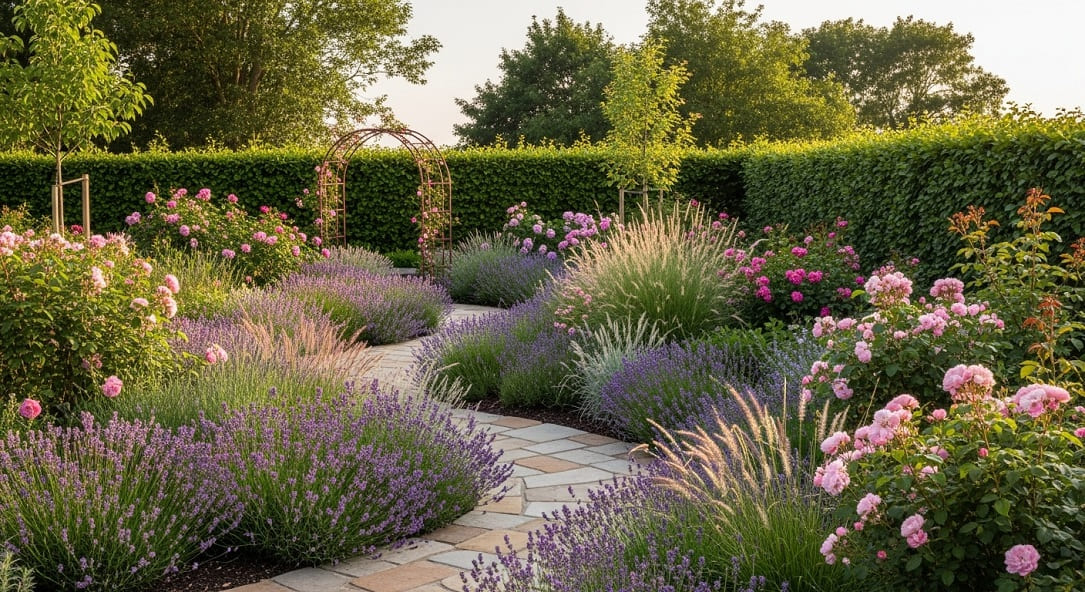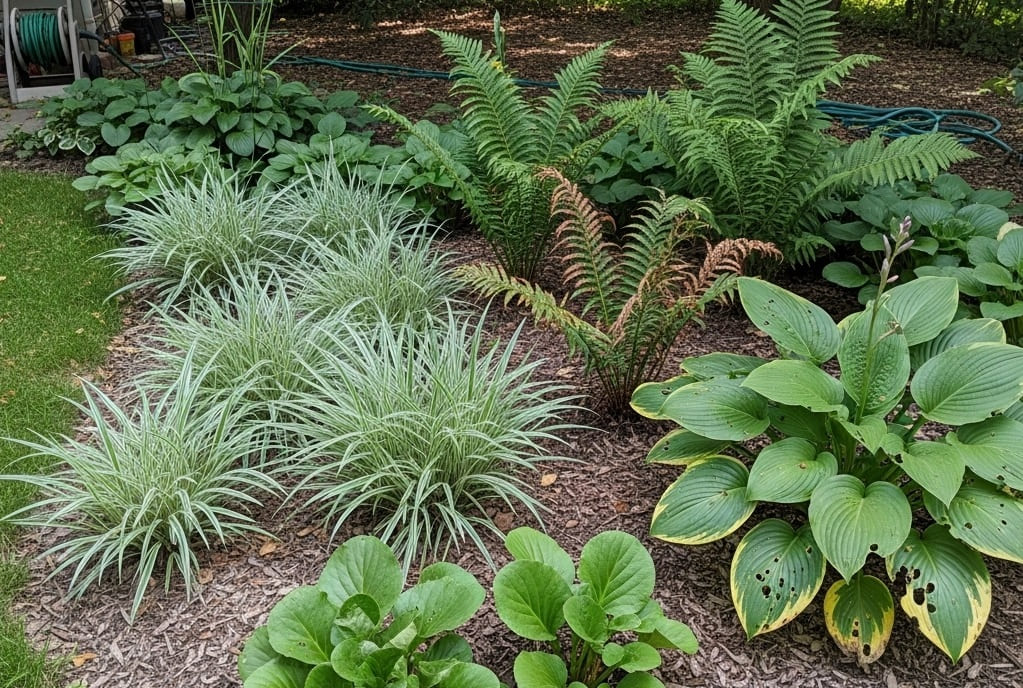Three years ago, I stood in my backyard feeling completely overwhelmed. Despite spending countless weekends at garden centers and investing in beautiful plants, my garden looked like a plant cemetery rather than the peaceful sanctuary I’d envisioned.
Every corner seemed to compete for attention, colors clashed instead of complemented, and the space felt chaotic rather than calming.
The turning point came during a visit to my grandmother’s modest garden. While my yard boasted expensive specimens, her simple space felt like stepping into a living poem. Roses climbed naturally alongside clematis, lavender created soft purple ribbons throughout the beds, and every element seemed to belong exactly where it was placed.
That afternoon, she shared a profound insight that changed my entire approach to gardening: “Harmony isn’t about having the most beautiful plants, dear. It’s about helping them sing together instead of trying to be soloists.”
This guide will show you how to create that same sense of natural harmony in your own garden, regardless of your budget, space size, or experience level.
Understanding the Foundation of Garden Harmony
Garden harmony isn’t accidental magic—it’s the result of understanding and applying fundamental design principles that work with nature rather than against it.
What Makes a Garden Feel “Right”
Have you ever walked into a garden and immediately felt at peace, even though you couldn’t quite explain why? That feeling comes from harmony—the seamless integration of elements that creates visual and emotional coherence.
Unlike a museum display where individual pieces demand attention, a harmonious garden flows like a gentle conversation where each element supports and enhances the others.
True garden harmony addresses multiple senses simultaneously. The visual elements work together, sounds complement rather than compete (think gentle water features with rustling grasses), textures invite touch, and fragrances blend rather than clash. This multi-sensory approach creates spaces that feel naturally soothing and invite lingering.

The Three Pillars of Garden Harmony
- Unity
Unity means every element in your garden should feel connected to the whole. This doesn’t require everything to match perfectly, but there should be recurring themes that tie the space together.
These themes might include repeated colors that appear in different plants throughout the seasons, similar textures that create visual connections between distant areas, or consistent materials that provide subtle continuity.
- Balance
Balance involves thoughtful distribution of visual weight throughout your space. A large tree on one side might be balanced by a group of smaller shrubs on the other, or a bright flower bed might be offset by an area of calm green foliage.
Balance also applies to seasonal interest—you want beauty distributed throughout the year rather than concentrated in just one spectacular month.
- Rhythm
Rhythm creates movement and flow through repetition and pattern. Like music, gardens benefit from themes that return and develop. This might mean repeating a particular plant combination at intervals, creating pathways that guide the eye naturally through the space, or establishing patterns in height, color, or texture that create visual movement.
Working with Your Site’s Natural Characteristics
Before imposing any design vision, spend time understanding what your site wants to become. Walk your space at different times of day and in different seasons. Notice where water naturally flows, which areas stay damp or dry quickly, where morning sun gives way to afternoon shade, and which spots feel naturally sheltered or exposed.
My neighbor learned this lesson when she tried to create a formal rose garden in an area that stayed soggy after rain. After two years of struggling plants, she embraced the site’s wetness and created a beautiful rain garden filled with astilbe, cardinal flower, and moisture-loving ferns.
The result was not only more successful but infinitely more harmonious because it worked with rather than against the natural conditions.
The Art of Visual Balance in Garden Design
Creating balance doesn’t mean making everything symmetrical—in fact, the most interesting gardens often achieve what designers call “asymmetrical balance.”
Working with Symmetrical Balance
Formal symmetrical balance works beautifully in structured settings and can create instant calm in chaotic environments. Picture a central pathway with identical plantings on either side, or a fountain surrounded by evenly spaced shrubs.
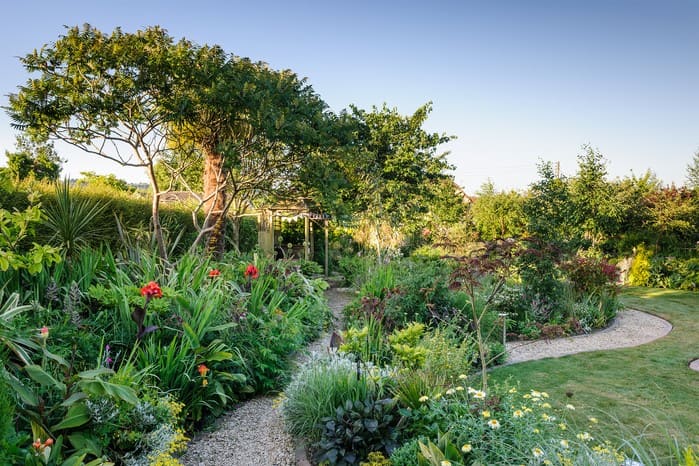
This approach creates a sense of order and tranquility that’s particularly effective in smaller spaces, formal settings, or areas where you want to emphasize rest and contemplation.
Symmetrical balance works especially well for entrance gardens, where the formal approach creates a welcoming sense of order, herb gardens where organization serves function, and small courtyard spaces where structure can make the area feel larger and more intentional.
Mastering Asymmetrical Balance
Asymmetrical balance feels more natural and dynamic while still maintaining visual stability. You achieve this by balancing different elements that have equivalent visual weight—a large tree on one side might be balanced by a cluster of medium-sized shrubs and colorful perennials on the other.
The key to successful asymmetrical balance lies in understanding visual weight. Dark colors, large masses, and complex textures all carry more visual weight than light colors, small plants, or simple forms.
A single dark purple smokebush might balance several light green ornamental grasses, or one bold architectural plant like a yucca might balance a whole group of delicate perennials.

Scale and Proportion: Getting the Size Relationships Right
Nothing disrupts garden harmony faster than elements that are wildly out of proportion to their surroundings. That magnificent hosta that looked perfect in the nursery might overwhelm a small border, while tiny annuals can disappear completely in a large landscape.
Consider both immediate impact and long-term growth when making scale decisions. A small Japanese maple might look insignificant when first planted but will grow to perfect proportions in five years.

Fast-growing plants can provide immediate impact while slower-growing specimens develop, but plan for eventual removal or relocation of the temporary fillers.
Proportion also applies to hardscape elements—pathways should be wide enough for their intended use without overwhelming the planted areas, seating should be appropriately scaled to both the space and the people who will use it, and structures like arbors or pergolas should relate logically to nearby buildings and mature plant sizes.
Creating Unity Through Repetition and Echoes
One of the most powerful tools for creating garden harmony is repetition, but not the kind that leads to boring, predictable rows of identical plants.
Simple Echoes: The Foundation of Cohesion
Simple echoes involve repeating obvious elements like flower colors or plant forms throughout your garden. If you have pink roses in one bed, echo that pink with astilbe in a shadier area, or repeat it with the soft pink flowers of a flowering cherry tree.
The key is repetition with variation—using the same color in different plants, different seasons, or different contexts.
I discovered the power of simple echoes by accident when I planted white flowers randomly throughout my first garden design. Without realizing it, I had created a unifying thread—white tulips in spring were followed by white roses in summer, white asters in fall, and the white bark of birch trees in winter.
Visitors always commented on how “pulled together” the garden looked, even though I hadn’t planned the repetition consciously.
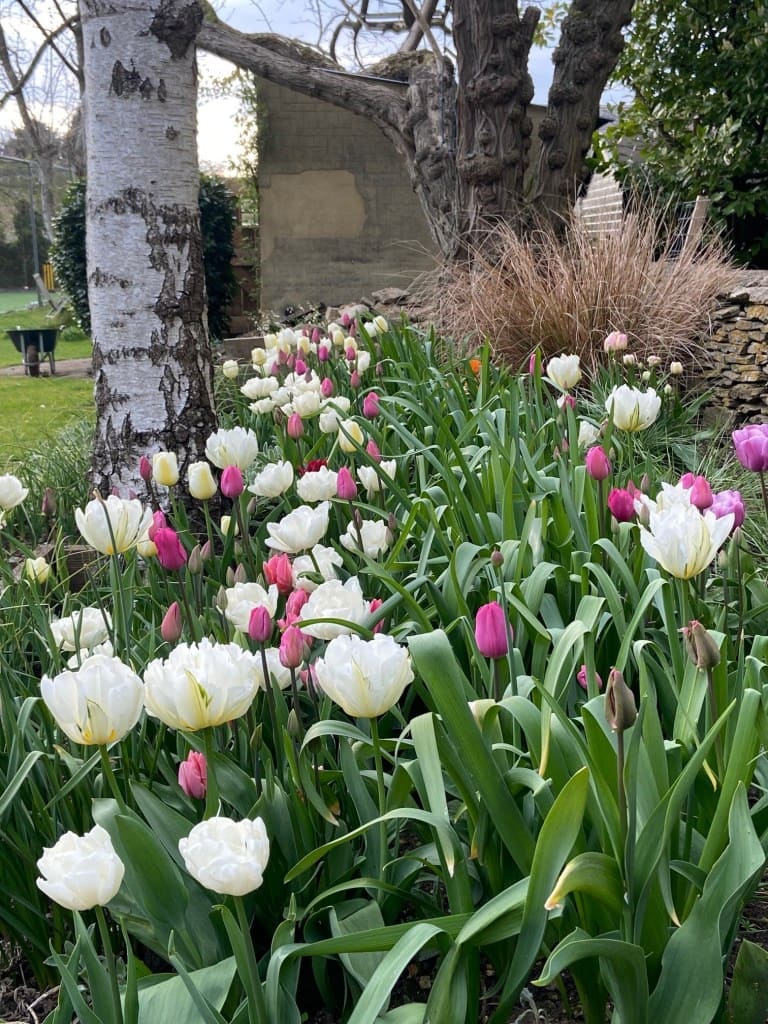
The most effective simple echoes use colors that appear in multiple seasons. Purple works beautifully because it appears in early crocuses, late summer asters, and the fall foliage of many trees. Yellow creates cheerful threads from early daffodils through summer lilies to autumn maple leaves.
Complex Echoes: Sophisticated Connections
Complex echoes require a more trained eye but create incredibly sophisticated results. Instead of repeating flower colors, you might echo the burgundy stems of a dogwood with the burgundy foliage of a heuchera, or repeat the silver-gray of lavender foliage with the silvery seed heads of ornamental grasses in winter.
Look for unexpected sources of color and texture to create these subtle connections. The reddish stems of blueberry bushes might echo the red autumn foliage of a distant maple.
The fuzzy texture of lamb’s ear might be repeated in the soft seed heads of ornamental grasses. The glossy surface of evergreen leaves might be echoed in the reflective surface of a water feature.
Complex echoes often work across seasons, connecting your garden’s year-round structure. The gray bark of a beech tree might echo the silver foliage of artemisia in summer and the gray-brown seed heads of perennials in winter.
Texture Repetition: The Underused Harmony Tool
Texture creates some of the most satisfying echoes because it engages our sense of touch even when we’re just looking. The fine, feathery texture of ornamental grasses might be echoed by the delicate fronds of ferns in shadier areas, or the bold, architectural leaves of hostas might be repeated by the dramatic foliage of large-leaved bergenia.
Textural repetition is particularly effective because it works even when plants aren’t blooming. The fine texture that connects your summer grasses to your shaded ferns continues to provide harmony throughout the seasons, while flower color comes and goes.
Consider creating textural themes that run through your entire garden. A “fine texture” theme might include ornamental grasses, ferns, small-leaved boxwood, and delicate perennials like asters. A “bold texture” theme could feature hostas, bergenia, large-leaved hydrangeas, and architectural shrubs like rhododendrons.
Color Harmony: Beyond Basic Color Wheels
While understanding complementary and analogous colors is helpful, creating true color harmony in gardens requires going deeper than basic color theory.
Working with Nature’s Palette
Nature rarely produces the pure, saturated colors found on color wheels. Garden colors are modified by light, shadows, surrounding plants, and seasonal changes. Instead of forcing theoretical color combinations, observe how colors actually behave in your specific garden conditions.
Morning light brings out cool tones and makes white flowers glow, while evening light warms colors and makes reds and oranges more vibrant. Shaded areas tend to mute colors and make subtle differences more apparent, while bright sun can wash out pale colors and intensify darker ones.
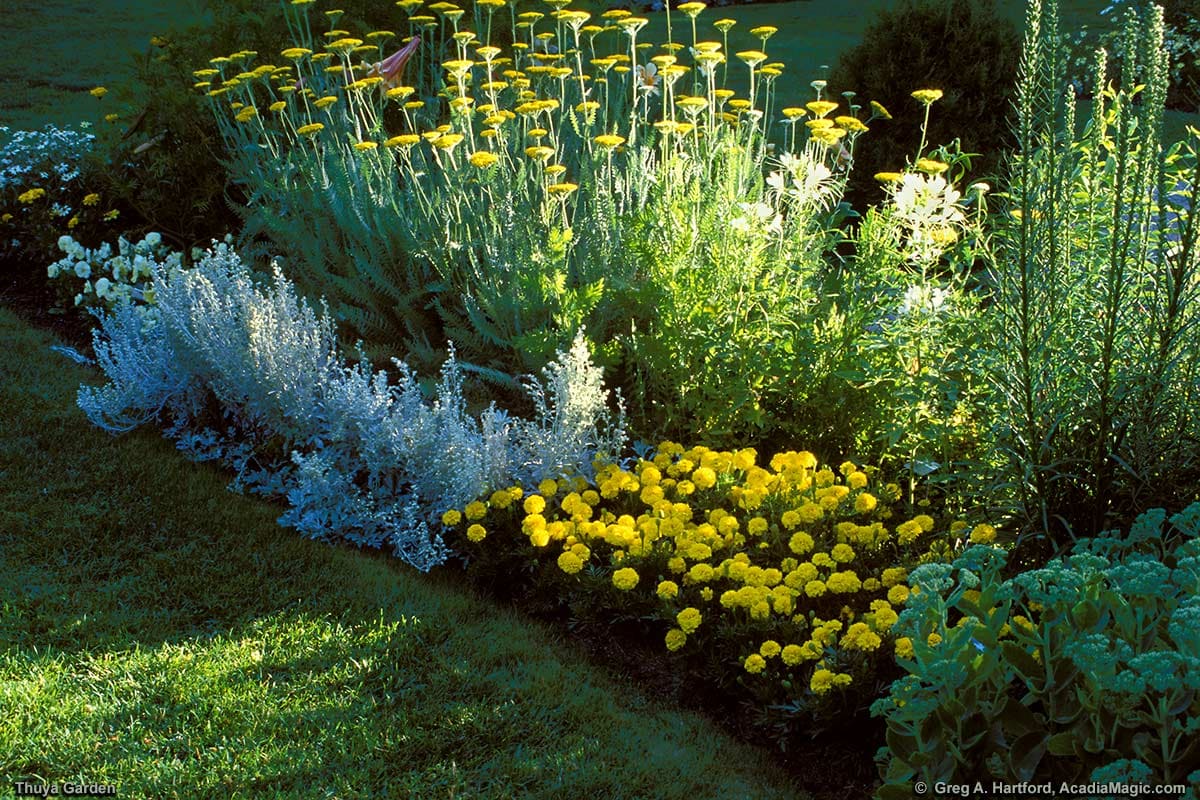
The most harmonious color schemes often rely on nature’s own combinations. Think of a woodland in spring—soft green foliage, white dogwood flowers, purple violets, and the brown of tree trunks create a naturally pleasing palette that you can translate to your garden using cultivated plants with similar colors.
The Power of Foliage Colors
Flowers grab attention, but foliage colors create the foundation of garden harmony. Green isn’t just green—it ranges from the blue-green of hostas to the yellow-green of new growth, from the deep forest green of evergreens to the silvery-green of artemisia.
Learning to see and work with foliage color variations will elevate your garden design dramatically. Blue-green foliage plants like many hostas, blue spruces, and rue create cool, calming effects and pair beautifully with silver-leaved plants and white or pale yellow flowers.

Yellow-green foliage like that of golden hakone grass or chartreuse heucheras creates energy and pairs well with purple flowers and burgundy foliage.
Don’t overlook seasonal foliage color changes. Many plants that have modest green summer foliage transform into brilliant yellows, oranges, or reds in fall. Planning for these seasonal color shifts allows you to create harmonious displays that evolve throughout the year.
Seasonal Color Progression
Plan your color harmony across seasons rather than just focusing on peak summer display. This requires thinking beyond flowers to include the colors of emerging foliage, autumn changes, winter bark, and even the colors of decomposing leaves.
Spring might feature the soft greens of emerging foliage, pale yellows of early bulbs, and fresh pink and white of flowering trees. Summer could embrace richer, more saturated colors—deep blues, vibrant reds, and lush greens.

Fall might shift to warm oranges, golden yellows, and burgundy reds, while winter could rely on evergreen structures, interesting bark colors, and the subtle browns and tans of dried grasses and seed heads.
One of my most successful seasonal color experiments involved creating what I call a “golden thread” that runs through my garden year-round.
It starts with yellow crocuses in early spring, moves through golden daffodils and yellow tulips, continues with yellow roses and golden hostas in summer, peaks with golden autumn foliage, and finishes with the golden bark of willow trees highlighted against winter snow.
Understanding Soil and Its Impact on Harmony
Healthy soil is the foundation of garden harmony—struggling plants create visual discord no matter how carefully planned your color scheme.
Reading Your Soil’s Story
Before selecting plants, understand what your soil wants to support. Clay soils that stay moist can support lush, large-leaved plants that would struggle in sandy conditions. Sandy soils that drain quickly are perfect for Mediterranean plants that would rot in heavy clay.
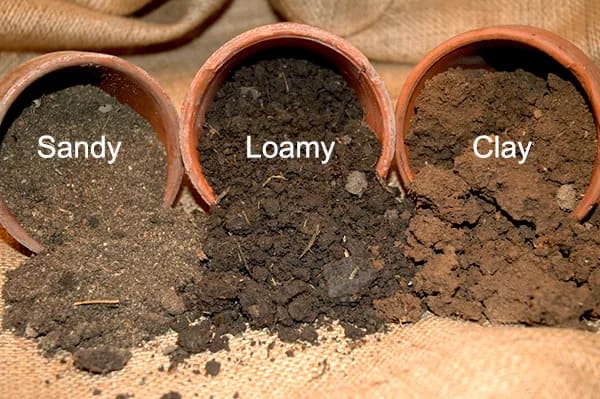
Work with your soil’s natural characteristics rather than fighting them. If you have naturally acidic soil, embrace acid-loving plants like azaleas, rhododendrons, and blueberries rather than struggling to grow plants that prefer alkaline conditions.
If your soil is naturally alkaline, choose plants that thrive in those conditions rather than constantly amending to lower the pH.
Here’s How to Add Nitrogen to Soil with 18 Quick Fixes + Long-Term Solutions
Creating Microclimates for Plant Success
Your garden likely contains several different microclimates created by variations in sun, shade, moisture, and wind exposure. Understanding and working with these microclimates will help you place plants where they’ll thrive, which is essential for long-term harmony.
That spot against your south-facing wall might be perfect for heat-loving plants, while the area under your maple tree might support woodland plants that would struggle in full sun. Low-lying areas might stay moist enough for plants that would need constant watering on slopes, while hilltops might be perfect for drought-tolerant plants.
Successful microclimate gardening means matching plants to places rather than trying to modify places to match plants. The most harmonious gardens are those where plants are obviously thriving in their chosen locations.
Plant Partnerships That Create Natural Harmony
Some plant combinations achieve instant harmony because they complement each other naturally—whether through synchronized bloom times, complementary colors, or beneficial growing relationships.
Time-Tested Harmony Partnerships
- Roses and Lavender create the classic cottage garden combination that works because the soft purple of lavender enhances any rose color while providing a calming backdrop. Both love full sun and well-drained soil, and lavender’s drought tolerance helps reduce water needs. The combination also provides extended seasons of interest—lavender blooms continue after many roses finish their first flush.
- Hostas and Ferns excel in shaded areas, creating lush, layered texture while requiring minimal maintenance. The bold leaves of hostas contrast beautifully with the delicate fronds of ferns, and both plants help suppress weeds while creating a cool, woodland atmosphere.
- Ornamental Grasses and Sedums represent modern garden harmony, thriving in sunny, well-drained areas while providing year-round interest. The flowing movement of grasses contrasts with the architectural forms of sedums, and both look stunning through winter when many other plants have died back.
- Tulips and Daffodils create the quintessential spring display, with bloom times that often overlap and colors that complement rather than compete. Daffodils naturalize easily and return year after year, while tulips can be treated as annuals for maximum color impact.
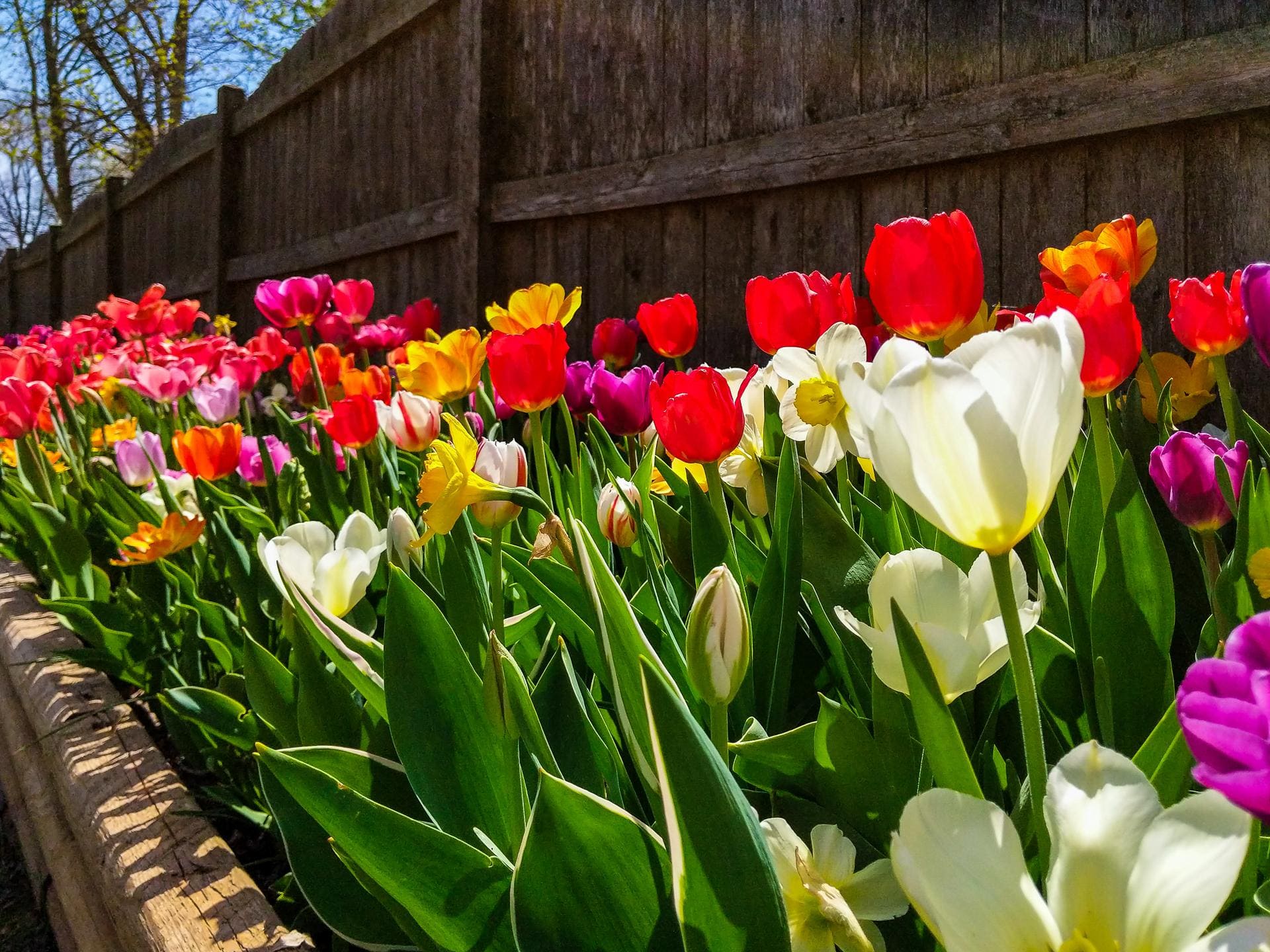
Creating Your Own Successful Partnerships
When developing plant partnerships for your garden, consider multiple factors beyond simple visual appeal. Plants with similar cultural requirements naturally work well together because they thrive under the same conditions. Combine plants that prefer full sun and good drainage, or group those that enjoy partial shade and consistent moisture.
Think about bloom timing and sequence. Plants that flower in succession extend the display period and prevent overwhelming bursts of color followed by barren periods. Early spring bulbs can be followed by perennials that emerge to hide the bulbs’ dying foliage, which in turn can be succeeded by late-summer bloomers.
Consider complementary functions where one plant provides what another needs. Nitrogen-fixing plants like legumes can support heavy feeders nearby. Deep-rooted plants can bring nutrients up from lower soil layers to benefit shallow-rooted companions. Plants with dense foliage can provide the shade that more delicate neighbors require.
Companion Planting for Beauty and Function
Some plant partnerships serve double duty by providing beauty while supporting garden health. Marigolds with tomatoes, nasturtiums with cucumbers, and herbs throughout flower beds all demonstrate how functional planting can enhance rather than detract from garden beauty.
These functional partnerships often create the most sustainable and harmonious gardens because they work with natural relationships rather than requiring constant intervention. Plants that support each other naturally tend to look better together, creating visual harmony as a byproduct of ecological compatibility.
Creating Functional Zones While Maintaining Overall Harmony
Most gardens need to serve multiple functions—entertaining, relaxation, food production, and visual beauty. The challenge lies in creating distinct functional areas that still feel connected to the overall garden design.
Defining Spaces Without Barriers
Use subtle changes in plant height, texture, or color to suggest different areas rather than creating hard divisions with fences or walls. A shift from fine-textured ornamental grasses to broader-leaved perennials can signal the transition from a naturalistic area to a more formal seating space.
Changes in ground cover or pathway materials can also suggest different functions while maintaining visual flow.
Height transitions work particularly well for creating implied boundaries. Lower plants in seating areas make the space feel more intimate, while taller plantings can create privacy screens without blocking views entirely. Graduated heights that step up or down as you move between areas create natural transitions that feel intentional without being rigid.
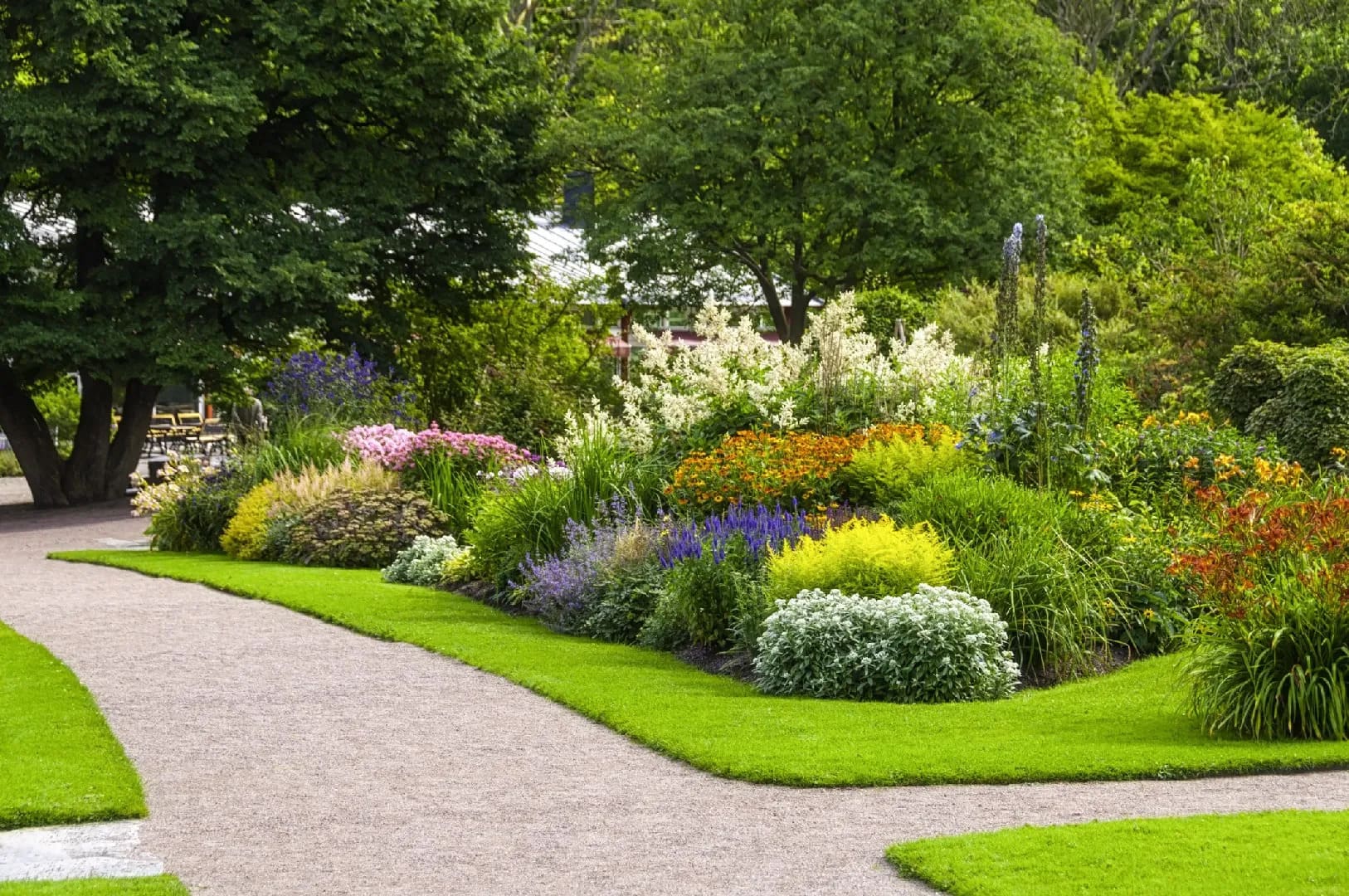
Integrating Productive and Ornamental Plants
Food gardens don’t have to be separated from ornamental areas. Many vegetables and herbs are beautiful enough to include in flower borders, while edible flowers can add both beauty and culinary interest to vegetable plots.
Purple kale, rainbow chard, and bronze fennel can hold their own in ornamental borders, while herbs like lavender, rosemary, and sage provide both culinary value and garden beauty. Fruit trees can serve as focal points in ornamental areas, providing spring flowers, summer shade, and autumn fruit.

The key to successful integration is choosing edible plants that match the style and growing conditions of your ornamental plants. Formal herb gardens might feature clipped boxwood edges and geometric patterns, while cottage-style gardens can accommodate more relaxed mixtures of vegetables, herbs, and flowers.
Read The Complete Guide to Edible Flowers: 25+ Varieties to Grow & Cook
Seasonal Functionality and Flexibility
Different seasons require different functions from your garden spaces. Summer might call for shaded seating areas and easy access to watering, while winter might prioritize protected spots for enjoying sunny days and views of interesting plant structures.
Design flexibility into your functional areas by using moveable elements where possible. Container plantings can be rearranged for different seasons or functions, portable seating can adapt to changing sun patterns, and temporary structures like shade cloth can modify spaces as needed.
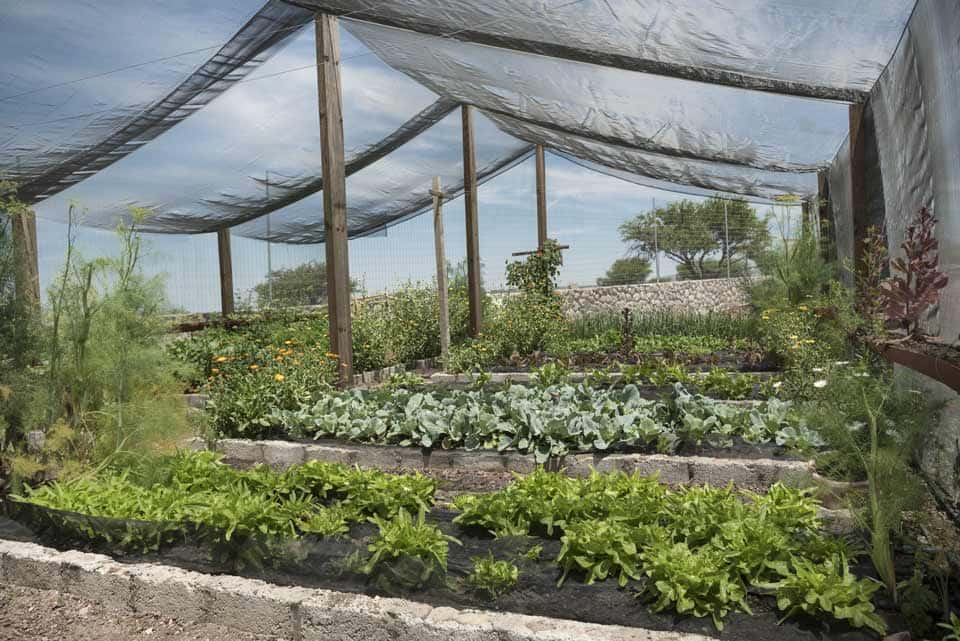
Lighting Design for Garden Harmony
Thoughtful lighting extends your garden’s harmony into evening hours while creating entirely new visual experiences after dark.
Natural Light Patterns Throughout the Day
Before adding artificial lighting, understand how natural light moves through your garden. Morning light creates different moods and reveals different colors than evening light. Areas that are beautiful in soft morning light might be harsh in bright afternoon sun, while spaces that seem unremarkable during the day might become magical in evening’s golden hour.
Plan your garden rooms and seating areas to take advantage of the best natural light for their intended use. Breakfast areas benefit from gentle morning sun, while evening entertaining spaces are enhanced by western light that creates warm, golden atmospheres as the sun sets.
Artificial Lighting That Enhances Rather Than Dominates
The best garden lighting feels natural and enhances the existing beauty rather than creating entirely artificial scenes. Subtle uplighting can reveal the structure of beautiful trees, while gentle path lighting improves safety without competing with the plants.
Avoid the temptation to light everything—darkness and shadow are important elements of nighttime garden harmony. Strategic lighting that reveals key features while allowing other areas to fade into soft darkness creates mystery and visual interest.
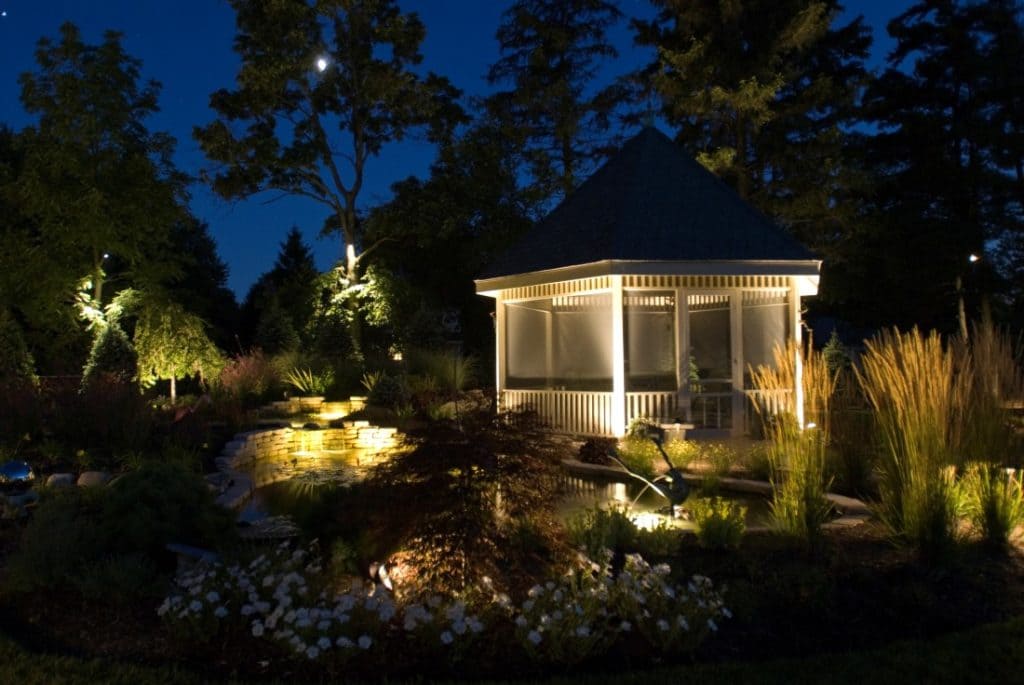
Consider the color temperature of your lighting choices. Warm light (2700K-3000K) tends to be more harmonious with natural settings, while cooler light can feel harsh and artificial in garden environments.
Here’s How to Attract Fireflies to Your Garden And Create a Firefly-Friendly Habitat
Budget-Friendly Approaches to Garden Harmony
Creating a harmonious garden doesn’t require expensive plants or professional design services. Some of the most beautiful gardens achieve harmony through thoughtful use of humble materials and plants.
Starting Small and Building Gradually
Begin with one small area and perfect the harmony there before expanding to the rest of your garden. This approach allows you to learn what works in your specific conditions while spreading costs over time. Success in one area also provides a template that can be adapted and repeated throughout your garden.
Choose a high-impact area for your first harmony project—perhaps the view from your kitchen window or the area around your front entrance. Success in these prominent locations will be noticed and appreciated daily, providing motivation to continue developing the rest of your garden.
Maximizing Impact with Repetition
Repeating a limited number of plant varieties throughout your garden creates more impact than using many different plants once. Three large groupings of the same perennial will create more harmony and visual weight than nine different perennials used singly.
Buy smaller plants and be patient for them to grow rather than purchasing expensive mature specimens. Many perennials can be divided after their first or second year, effectively multiplying your investment. Seeds and cuttings from friends’ gardens can provide free plants while creating connections to people you care about.
Here’s How to Propagate Plants in Water: Easy Step-by-Step Method
Working with Free and Found Materials
Nature provides many opportunities for free materials that can enhance garden harmony. Fallen branches can become rustic borders or plant supports, stones from construction sites can create pathways or accents, and autumn leaves make excellent compost and mulch.
Many municipalities offer free mulch, compost, or even plants from their maintenance operations. Connect with local gardening groups to share plants, seeds, and materials. Master Gardener programs often have plant sales with high-quality plants at reasonable prices.
Choosing High-Impact, Low-Cost Plants
Some plants provide maximum harmony impact for minimal investment. Ornamental grasses, many perennials, and self-seeding annuals like calendulas and cosmos provide abundant beauty for modest cost. Plants that naturalize or self-seed effectively multiply your investment year after year.
Focus on plants that provide multiple seasons of interest rather than those with brief but spectacular displays. A plant that offers spring flowers, summer foliage, autumn color, and winter structure provides much better value than one that shines for only two weeks.
Dealing with Common Harmony Challenges
Every garden presents unique challenges that can disrupt harmony if not addressed thoughtfully.
Problem Areas and How to Transform Them
Steep slopes, wet areas, dense shade, and poor soil all present opportunities for creative solutions that can become garden highlights rather than problems to hide.
Slopes might become stunning rock gardens or naturalistic meadows, wet areas can support lush bog gardens or rain gardens, and shaded areas offer opportunities for woodland gardens with subtle beauty.

The key to successful problem-area solutions is embracing the conditions rather than fighting them. Plants that thrive in your problem conditions will look happier and more natural than struggling specimens that require constant intervention.
Integrating Existing Elements
Most gardens include elements that can’t be easily changed—mature trees, existing structures, or neighboring views that you must work with rather than around. The most harmonious gardens integrate these fixed elements seamlessly into the overall design.
Large trees can become focal points around which the rest of the garden is organized. Existing structures can be softened with appropriate plantings or enhanced with complementary materials. Even unattractive neighboring views can be minimized through strategic screening while preserving desirable sightlines.
Transition Challenges Between Different Areas
Gardens often need to accommodate different styles or functions in different areas, and the transitions between these areas can be jarring if not handled carefully. Gradual transitions work better than abrupt changes—use intermediate plants or materials that share characteristics with both areas to create smooth visual bridges.
Color can be particularly effective for creating smooth transitions. A plant that picks up a color from the formal area and carries it into the naturalistic area helps the spaces feel connected even when their styles differ significantly.
Maintenance Strategies That Support Long-Term Harmony
Even the most beautifully designed garden requires ongoing care to maintain its harmony, but smart maintenance strategies can minimize work while maximizing impact.
Pruning for Harmony
Regular pruning isn’t just about plant health—it’s about maintaining the forms and proportions that create harmony. Shrubs that outgrow their intended size can throw off the balance of an entire area, while perennials that aren’t deadheaded can look chaotic rather than natural.

Develop a seasonal pruning schedule that maintains your design intent while working with each plant’s natural growth patterns. Some plants look best with frequent light pruning, while others benefit from annual hard pruning or should be left to develop natural forms.
Here’s How to Prune Roses: A Simple Guide for Stunning Results
Seasonal Editing and Refinement
Use seasonal maintenance as an opportunity to evaluate and refine your harmony. Are certain areas becoming overgrown and unbalanced? Do color combinations that looked good on paper clash in reality? Are plants thriving where you placed them, or do they need relocation?
The most successful gardens evolve gradually through this process of observation and adjustment. Be willing to move plants, divide overgrown specimens, or remove elements that aren’t contributing to the overall harmony.
Sustainable Maintenance Practices
Maintenance practices that work with natural processes rather than against them tend to support garden harmony while reducing work. Mulching with organic materials improves soil health while suppressing weeds and conserving moisture. Composting garden waste returns nutrients to the soil while reducing the need for fertilizers.
Choose plants that don’t require intensive maintenance to look their best. A plant that needs constant deadheading, frequent division, or special protection might be beautiful individually but disruptive to overall garden harmony if it requires disproportionate attention.
Here’s How and Why to Deadhead Daylilies for Boosting Blooms
Troubleshooting Harmony Issues
When garden harmony feels elusive, systematic troubleshooting can help identify and resolve the underlying issues.
Identifying What’s Not Working
Step back and try to see your garden with fresh eyes, or ask a trusted friend to help identify areas that feel “off.” Common harmony disruptors include plants that are out of scale for their location, color combinations that clash rather than complement, and areas that feel overly busy or chaotically planted.
Take photos of your garden from different angles and at different times of year. Sometimes problems that are hard to see in person become obvious in photographs. Look for areas where your eye doesn’t know where to rest, or places where multiple elements compete for attention without a clear hierarchy.
Common Quick Fixes
Many harmony issues can be resolved with relatively simple adjustments. Removing or relocating one problematic plant can sometimes restore balance to an entire area. Adding repetition of successful elements can often tie together disparate areas that feel disconnected.
Sometimes the solution is addition rather than subtraction—a single large plant might provide the visual weight needed to balance a busy area, or repeating a successful color combination in a new location might create the echo needed to unify different spaces.
When to Consider Major Changes
Occasionally, achieving harmony requires more significant changes—relocating large plants, redesigning pathways, or reconsidering the fundamental organization of your space. These decisions shouldn’t be made hastily, but sometimes a major change can transform a frustrating space into a harmonious one.
Before making major changes, live with your garden through at least one complete growing season. Gardens look very different in spring, summer, fall, and winter, and what seems like a major problem in one season might resolve itself in another.
Frequently Asked Questions About Garden Harmony
- How long does it take to create a harmonious garden?
Garden harmony is an ongoing process rather than a destination. You can see improvements in the first season by applying basic principles like repetition and appropriate plant placement, but most gardens take 3-5 years to reach their full potential as plants mature and you refine your design.
The good news is that even small improvements toward harmony are immediately noticeable and satisfying.
- Can I create harmony in a small space like a balcony or tiny yard?
Absolutely! Small spaces often achieve harmony more easily because it’s easier to control all the elements. Focus on a limited color palette, repeat materials and plants even in small numbers, and choose appropriately scaled elements.
Vertical space becomes especially important in small gardens—use climbing plants, wall-mounted containers, and varied heights to create interest without overwhelming the space.
- How do I maintain harmony when I want to try new plants?
Add new plants within your established palette rather than completely changing direction. If your garden focuses on purple, white, and silver, look for new plants in those colors rather than introducing orange or bright red.
You can also designate one small area as your “experimental zone” separate from your main harmonious design, or test new plants in containers before committing to permanent placement.
- What if I inherit a garden that feels chaotic?
Start by identifying what’s working and build from there. Often, a chaotic garden just needs strategic editing rather than complete redesign.
Remove obvious problems first—dead or struggling plants, overgrown specimens, or elements that clearly clash. Then gradually refine and enhance the remaining elements. Take photos to help you see the garden objectively, and don’t try to fix everything at once.
- How much should I spend to create garden harmony?
Harmony comes more from thoughtful design than expensive plants. You can create a beautiful, harmonious garden on any budget by focusing on good plant combinations, careful placement, and patience for growth.
Start with a few well-chosen plants and expand gradually rather than trying to fill everything at once. Many of the most harmonious gardens rely on simple, readily available plants used thoughtfully rather than exotic expensive specimens.
- Should I hire a professional designer to create harmony?
While professional help can be valuable, especially for complex sites or major renovations, most gardeners can create harmony by applying basic principles and taking time to observe and adjust.
Start with small projects to build your confidence and understanding. If you do work with a professional, focus on learning their thought process so you can continue developing your garden’s harmony over time.
Conclusion: Your Garden Symphony Awaits
Creating a harmonious garden is both an art and a journey that unfolds over seasons and years. Like learning to play a musical instrument, it requires patience, practice, and the willingness to make adjustments along the way.
But unlike music, your garden will continue to grow and evolve, revealing new harmonies and surprising combinations as seasons pass and plants mature.
The most beautiful gardens aren’t necessarily those with the most exotic plants or expensive features—they’re the ones where every element feels like it belongs, where walking through the space brings peace rather than visual overload, and where the whole truly becomes greater than the sum of its parts.
Remember that harmony is personal. What feels balanced and peaceful to you might be different from what appeals to others, and that’s perfectly fine. Your garden should reflect your personality, your lifestyle, and your relationship with the natural world.
The principles in this guide provide a framework, but your creativity and intuition will guide the specific choices that make your garden uniquely yours.
Start with one small area and apply these principles thoughtfully. As you begin to see and feel the difference that harmony makes, you’ll develop an intuitive sense for what works in your space. Pay attention to how different combinations make you feel, notice which areas draw you in and which make you want to hurry past, and adjust accordingly.
Most importantly, don’t be afraid to experiment, make mistakes, and adjust your approach. Every great garden is really a series of successful experiments that grew into something beautiful.
Some of your best discoveries will come from happy accidents—the self-seeded flower that finds the perfect spot, the plant that thrives where you least expected it, or the color combination that emerges naturally from your carefully planned plantings.
Your garden is waiting to sing in harmony—it just needs a thoughtful conductor to help all the elements find their voices. Take it one season at a time, one plant combination at a time, and trust that patience and observation will guide you toward the peaceful, beautiful sanctuary you’re seeking to create.
The journey toward garden harmony begins with a single thoughtful plant placement and grows into a lifetime of discovery and delight. Your perfect outdoor sanctuary is not a destination but a continuing conversation between you, your plants, and the natural world around you. Why not step outside today and begin that beautiful conversation?
